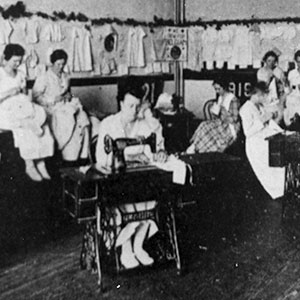
Throughout 1918, ECTTS students, faculty, and administrators did their part to help win World War I. That year the Training School Quarterly praised and exhorted all on campus to make additional, even extraordinary contributions of every kind. TSQ illustrated one kind of service with pictures of students, their class banners 1918, 1919, 1921 proudly displayed, working in a room full of sewing machines making layettes, or blankets for newborns, for Belgian babies.
According to one account, “Interest in sewing for the Red Cross has been very greatly increased by the new work, that of making layettes for the refugee babies. The girls are taking the greatest delight in making the tiny garments. The auxiliary had the money in hand for five full layettes and hopes later to be able to make more. This sewing keeps a number of girls at work because sewing and crocheting can be done at the same time, and the girl who hates to sew but loves to crochet can get her chance to contribute work.” Also popular was knitting wool garments for brothers and friends in the service.
In a 1918 commencement address he delivered at the school, President Robert Wright lent his moral authority to the cause of campus involvement. Wright’s address, “The Place of Public Education in the Present World Crisis,” was also published in 1918 as the lead article in one issue of the Training School Quarterly. The address emphasized the importance of giving to the Red Cross, as well as the need for educating Americans so that victory would not be lost to ignorance. Wright delivered the address rather than bring in an outside speaker as part of a campus effort to economize for the sake of supporting efforts geared toward war relief. Along similar lines, a News and Observer editorial was republished calling on women teachers to engage in summer work for the Junior Red Cross, war savings associations, and other forms of national service.
More strenuously, the TSQ noted that “nearly all the girls … had been picking cotton at some time this fall.” Before Thanksgiving, 10,000 pounds had been harvested, bringing in $175.00 for humanitarian causes. Realizing that cotton remained in the fields, East Carolina girls began “picking for the support of the refugee baby.” The school apparently had decided to adopt a refugee baby thinking that if each girl picked cotton for one hour, the school could support “a baby kept in its home in France or Belgium.” This “newest phase of war work,” i.e., picking cotton, soon became the most popular on campus, “even rivaling the sewing for the Belgian babies in the spring.” Long before Rosie the Riveter inspired females to help out in World War II, the women of East Carolina were mobilized as a campus force making layettes and picking cotton for the allied cause.
Sources
- “Cotton Picking the Fashion.” Training School Quarterly. Vol. 5, no. 3. October, November, December 1918.
- “Knitting for the Boys.” Training School Quarterly. Vol. 4, no. 4. January, February, March 1918.
- “Simplified Commencement.” Training School Quarterly. Vol. 4, no. 4. January, February, March 1918.
- “Sewing for the Refugee Babies.” Training School Quarterly. Vol. 4, no. 4. January, February, March 1918.
- “Summer War Work for Women Teachers.” Training School Quarterly. Vol. 5, no. 2. July, August, September 1918.
- “Supporting a Refugee Baby on Cotton Money.” Training School Quarterly. Vol. 5, no. 3. October, November, December 1918.
- “War Talks by President Wright.” Training School Quarterly. Vol. 4, no. 4. January, February, March 1918.
- “War Work in Our Schools.” Training School Quarterly. Vol. 5, no. 3. October, November, December 1918.
- Wright, Robert H. “The Place of Public Education in the Present World Crisis.” Training School Quarterly. Vol. 5, no. 2. July, August, September 1918.
Citation Information
Title: Red Cross Workroom
Author: John A. Tucker, PhD
Date of Publication:6/1/2018